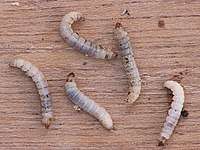Brown trout
The brown trout (Salmo trutta) is a European species of salmonid fish that has been widely introduced into suitable environments globally. It includes purely freshwater populations, referred to as the riverine ecotype, Salmo trutta morpha fario, a lacustrine ecotype, S. trutta morpha lacustris, also called the lake trout,[3][4] and anadromous forms known as the sea trout, S. trutta morpha trutta. The latter migrates to the oceans for much of its life and returns to fresh water only to spawn.[5] Sea trout in Ireland and Britain have many regional names: sewin in Wales, finnock in Scotland, peal in the West Country, mort in North West England, and white trout in Ireland.
| Brown trout | |
|---|---|
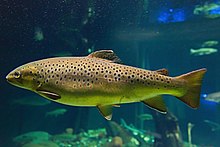 | |
| Scientific classification | |
| Kingdom: | Animalia |
| Phylum: | Chordata |
| Class: | Actinopterygii |
| Order: | Salmoniformes |
| Family: | Salmonidae |
| Genus: | Salmo |
| Species: | S. trutta |
| Binomial name | |
| Salmo trutta | |
| Morphs | |
|
Salmo trutta morpha trutta | |
| Synonyms[2] | |
|
previous scientific names
| |
The lacustrine morph of brown trout is most usually potamodromous, migrating from lakes into rivers or streams to spawn, although evidence indicates some stocks spawn on wind-swept shorelines of lakes. S. trutta morpha fario forms stream-resident populations, typically in alpine streams, but sometimes in larger rivers. Anadromous and nonanadromous morphs coexisting in the same river appear genetically identical.[6] What determines whether or not they migrate remains unknown.
Taxonomy
The scientific name of the brown trout is Salmo trutta. The specific epithet trutta derives from the Latin trutta, meaning, literally, "trout". Behnke (2007) relates that the brown trout was the first species of trout described in the 1758 edition of Systema Naturae by Swedish zoologist Carl Linnaeus. Systema Naturae established the system of binomial nomenclature for animals. Salmo trutta was used to describe anadromous or sea-run forms of brown trout. Linnaeus also described two other brown trout species in 1758. Salmo fario was used for riverine forms. Salmo lacustris was used for lake-dwelling forms.[7]
Range
The native range of brown trout extends from northern Norway and White Sea tributaries in Russia in the Arctic Ocean to the Atlas Mountains in North Africa. The western limit of their native range is Iceland in the north Atlantic, while the eastern limit is in Aral Sea tributaries in Afghanistan and Pakistan.[8]
Introduction outside their natural range
Brown trout have been widely introduced into suitable environments around the world, including North and South America, Australasia, Asia, and South and East Africa. Introduced brown trout have established self-sustaining, wild populations in many introduced countries.[9] The first introductions were in Australia in 1864 when 300 of 1500 brown trout eggs from the River Itchen survived a four-month voyage from Falmouth, Cornwall, to Melbourne on the sailing ship Norfolk. By 1866, 171 young brown trout were surviving in a Plenty River hatchery in Tasmania. Thirty-eight young trout were released in the river, a tributary of the River Derwent in 1866. By 1868, the Plenty River hosted a self-sustaining population of brown trout which became a brood source for continued introduction of brown trout into Australian and New Zealand rivers.[10] Successful introductions into the Natal and Cape Provinces of South Africa took place in 1890 and 1892, respectively. By 1909, brown trout were established in the mountains of Kenya. The first introductions into the Himalayas in northern India took place in 1868, and by 1900, brown trout were established in Kashmir and Madras.[11]
Introduction to Americas
The first introductions in Canada occurred in 1883 in Newfoundland[12] and continued until 1933. The only Canadian regions without brown trout are Yukon and the Northwest Territories. Introductions into South America began in 1904 in Argentina. Brown trout are now established in Chile, Peru, and the Falklands.[10] In the 1950s and 1960s, Edgar Albert de la Rue, a French geologist, began the introduction of several species of salmonids on the remote Kerguelen Islands in the southern Indian Ocean. Of the seven species introduced, only brook trout, Salvelinus fontinalis, and brown trout survived to establish wild populations.[13] Sea-run forms of brown trout exceeding 20 lb (9.1 kg) are caught by local anglers on a regular basis.
The first introductions into the U.S. started in 1883 when Fred Mather, a New York pisciculturist and angler, under the authority of the U.S. Fish Commissioner, Spencer Baird, obtained brown trout eggs from a Baron Lucius von Behr, president of the German Fishing Society. The von Behr brown trout came from both mountain streams and large lakes in the Black Forest region of Baden-Württemberg.[8] The original shipment of "von Behr" brown trout eggs were handled by three hatcheries, one on Long Island, the Cold Spring Hatchery operated by Mather, one in Caledonia, New York, operated by pisciculturalist Seth Green, and other hatchery in Northville, Michigan. Additional shipments of "von Behr" brown trout eggs arrived in 1884. In 1885, brown trout eggs from Loch Leven, Scotland, arrived in New York. These "Loch Leven" brown trout were distributed to the same hatcheries. Over the next few years, additional eggs from Scotland, England, and Germany were shipped to U.S. hatcheries. Behnke (2007) believed all life forms of brown trout—anadromous, riverine, and lacustrine—were imported into the U.S. and intermingled genetically to create what he calls the American generic brown trout and a single subspecies the North European brown trout (S. t. trutta).[8]
In April 1884, the U.S. Fish Commission released 4900 brown trout fry into the Baldwin River, a tributary of the Pere Marquette River in Michigan. This was the first release of brown trout into U.S. waters. Between 1884 and 1890, brown trout were introduced into suitable habitats throughout the U.S.[8] By 1900, 38 states and two territories had received stocks of brown trout. Their adaptability resulted in most of these introductions establishing wild, self-sustaining populations.[10]
Conservation status
The fish is not considered to be endangered, although some individual stocks are under various degrees of stress mainly through habitat degradation, overfishing, and artificial propagation leading to introgression. Increased frequency of excessively warm water temperatures in high summer causes a reduction in dissolved oxygen levels which can cause "summer kills" of local populations if temperatures remain high for sufficient duration and deeper/cooler or fast, turbulent more oxygenated water is not accessible to the fish. This phenomenon can be further exacerbated by eutrophication of rivers due to pollution—often from the use of agricultural fertilizers within the drainage basin.
Overfishing is a problem where anglers fail to identify and return mature female fish into the lake or stream. Each large female removed can result in thousands fewer eggs released back into the system when the remaining fish spawn.
Another threat is other introduced organisms. For example, in Canada's Bow River, a non-native alga Didymosphenia geminata—common name rock snot (due to appearance)—has resulted in reduced circulation of water amongst the substrate of the river bed in affected areas. This, in turn, can greatly reduce the number of trout eggs that survive to hatch. Over time, this leads to reduction of the population of adult fish in the areas affected by the algae, forming a circle of decline. Rock snot is believed to have spread accidentally on the soles of the footwear of visitors from areas where the alga is native. The wide variety of issues that adversely affect brown trout throughout its range do not exclusively affect brown trout, but affect many or all species within a water body, thus altering the ecosystem in which the trout reside.
In small streams, brown trout are important predators of macroinvertebrates, and declining brown trout populations in these specific areas affect the entire aquatic food web.[14]
Global climate change is also of concern. S. trutta morpha fario prefers well-oxygenated water in the temperature range of 60 to 65 °F (16 to 18 °C). S. trutta bones from an archaeological site in Italy, and ancient DNA extracted from some of these bones, indicate that both abundance and genetic diversity increased markedly during the colder Younger Dryas period, and fell during the warmer Bølling-Allerød event.[15]
Cover or structure is important to trout, and they are more likely to be found near submerged rocks and logs, undercut banks, and overhanging vegetation. Structure provides protection from predators, bright sunlight, and higher water temperatures. Access to deep water for protection in winter freezes, or fast water for protection from low oxygen levels in summer are also ideal. Trout are more often found in heavy and strong currents.
Characteristics
Defining characteristics include a slender, reddish-brown body with a long, narrow head.
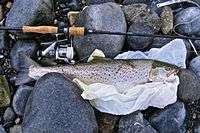
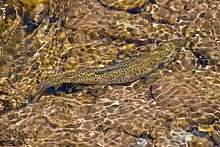
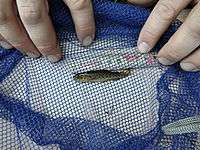

The brown trout is a medium-sized fish, growing to 20 kg (44 lb) or more and a length of about 100 cm (39 in) in some localities, although in many smaller rivers, a mature weight of 1.0 kg (2.2 lb) or less is common. S. t. lacustris reaches an average length of 40–80 cm (16–31 in) with a maximum length of 140 cm (55 in) and about 60 pounds (27 kg). The spawning behaviour of brown trout is similar to that of the closely related Atlantic salmon. A typical female produces about 2,000 eggs per kg (900 eggs per lb) of body weight at spawning. On September 11, 2009, a 41.45-lb (18.80-kg) brown trout was caught by Tom Healy in the Manistee River system in Michigan, setting a new state record. As of late December 2009, the fish captured by Healy was confirmed by both the International Game Fish Association and the Fresh Water Fishing Hall of Fame as the new all-tackle world record for the species. This fish now supplants the former world record from the Little Red River in Arkansas.
Brown trout can live 20 years, but as with the Atlantic salmon, a high proportion of males die after spawning, and probably fewer than 20% of anadromous female kelts recover from spawning . The migratory forms grow to significantly larger sizes for their age due to abundant forage fish in the waters where they spend most of their lives. Sea trout are more commonly female in less nutrient-rich rivers. Brown trout are active both by day and by night and are opportunistic feeders. While in fresh water, their diets frequently include invertebrates from the streambed, other fish, frogs, mice, birds, and insects flying near the water's surface. The high dietary reliance upon insect larvae, pupae, nymphs, and adults allows trout to be a favoured target for fly fishing. Sea trout are fished for especially at night using wet flies. Brown trout can be caught with lures such as spoons, spinners, jigs, plugs, plastic worm imitations, and live or dead baitfish. Freshwater brown trout range in colour from largely silver with relatively few spots and a white belly, to the more well-known brassy brown cast fading to creamy white on the fish's belly, with medium-sized spots surrounded by lighter halos. The more silver forms can be mistaken for rainbow trout. Regional variants include the so-called "Loch Leven" trout, distinguished by larger fins, a slimmer body, and heavy black spotting, but lacking red spots. The continental European strain features a lighter golden cast with some red spotting and fewer dark spots. Notably, both strains can show considerable individual variation from this general description. Early stocking efforts in the United States used fish taken from Scotland and Germany.
Brown trout rarely form hybrids with other species; if they do, they are almost invariably infertile. One such example is the tiger trout, a hybrid with the brook trout.
Diet
Field studies have demonstrated that brown trout fed on several animal prey species, aquatic invertebrates being the most abundant prey items. However, brown trout also feed on other taxa such as terrestrial invertebrates (e.g. Hymenoptera) or other fish.[16] Moreover, in brown trout, as in many other fish species, a change in the diet composition normally occurs during the life of the fish,[17] and piscivorous behaviour is most frequent in large brown trout.[18] These shifts in the diet during fish lifecycle transitions may be accompanied by a marked reduction in intraspecific competition in the fish population, facilitating the partitioning of resources.[19][20]
First feeding of newly emerged fry is very important for brown trout survival in this phase of the lifecycle, and first feeding can occur even prior to emergence.[21][22] Fry start to feed before complete yolk absorption and the diet composition of newly emerged brown trout is composed of small prey such as chironomid larvae or baetid nymphs.[23]
Stocking, farming and non-native brown trout
.gif)
The species has been widely introduced for sport fishing into North America, South America, Australia, New Zealand, and many other countries, including Bhutan, where they are the focus of a specialised fly fishery. First planting in the United States occurred April 11, 1884, into the Baldwin River, one mile east of Baldwin, MI.[24] Brown trout have had serious negative impacts on upland native fish species in some of the countries where they have been introduced, particularly Australia. Because of the trout's importance as a food and game fish, it has been artificially propagated and stocked in many places in its range, and fully natural populations (uncontaminated by allopatric genomes) probably exist only in isolated places, for example in Corsica or in high alpine valleys on the European mainland.
Farming of brown trout has included the production of infertile triploid fish by increasing the water temperature just after fertilisation of eggs, or more reliably, by a process known as pressure shocking. Triploids are favoured by anglers because they grow faster and larger than diploid trout. Proponents of stocking triploids argue, because they are infertile, they can be introduced into an environment that contains wild brown trout without the negative effects of cross-breeding. However, stocking triploids may damage wild stocks in other ways. Triploids certainly compete with diploid fish for food, space, and other resources. They could also be more aggressive than diploid fish and they may disturb spawning behaviour.
Scottish and Irish sea trout populations in recent years have seriously declined, possibly due to infestation by sea lice from salmon farms.[25]
Angling
The brown trout has been a popular quarry of European anglers for centuries. It was first mentioned in angling literature as "fish with speckled skins" by Roman author AElian (circa 200 AD) in On the Nature of Animals. This work is credited with describing the first instance of fly fishing for trout, the trout being the brown trout found in Macedonia.[26] The Treatyse of Fysshynge with an Angle (1496) by Dame Juliana Berners, O.S.B is considered a foundational work in the history of recreational fishing, especially fly fishing. One of the most prominent fish described in the work is the brown trout of English rivers and streams:
The trout, because he is a right dainty fish and also a right fervent biter, we shall speak of next. He is in season from March until Michaelmas. He is on clean gravel bottom and in a stream.
— Treatyse of Fysshynge with an Angle (1496)[27]
The renowned The Compleat Angler (1653) by Izaak Walton is replete with advice on "the trout":
The Trout is a fish highly valued, both in this and foreign nations. He may be justly said, as the old poet said of wine, and we English say of venison, to be a generous fish: a fish that is so like the buck, that he also has his seasons; for it is observed, that he comes in and goes out of season with the stag and buck. Gesner says, his name is of a German offspring; and says he is a fish that feeds clean and purely, in the swiftest streams, and on the hardest gravel; and that he may justly contend with all fresh water fish, as the Mullet may with all sea fish, for precedency and daintiness of taste; and that being in right season, the most dainty palates have allowed precedency to him.
— The Compleat Angler, (1653)[28]
Throughout the 17th, 18th, and 19th centuries, angling authors, mostly British, some French, and later American, writing about trout fishing were writing about fishing for brown trout. Once brown trout were introduced into the U.S. in the 1880s, they became a major subject of American angling literature. In 1889, Frederic M. Halford, a British angler, author published Dry-Fly Fishing in Theory and Practice, a seminal work codifying a half century of evolution of fly fishing with floating flies for brown trout. In the late 19th century, American angler and writer Theodore Gordon, often called the "Father of American Dry Fly Fishing" perfected dry-fly techniques for the newly arrived, but difficult-to-catch brown trout in Catskill rivers such as the Beaverkill and Neversink Rivers.[29] In the early 20th century, British angler and author G. E. M. Skues pioneered nymphing techniques for brown trout on English chalk streams. His Minor Tactics of the Chalk Stream (1910) began a revolution in fly fishing techniques for trout.[30] In 1917, Scottish author Hamish Stuart published the first comprehensive text, The Book of The Sea Trout, specifically addressing angling techniques for the anadromous forms of brown trout.[31]
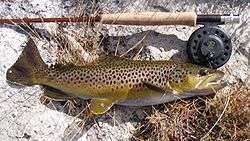
Introductions of brown trout into the American West created new angling opportunities, none so successful from an angling perspective as was the introduction of browns into the upper Firehole River in Yellowstone National Park in 1890.[32] One of the earliest accounts of trout fishing in the park is from Mary Trowbridge Townsend's 1897 article in Outing Magazine "A Woman's Trout Fishing in Yellowstone Park" in which she talks about catching the von Behr trout in the river:
Long dashes down stream taxed my unsteady footing; the sharp click and whirr of the reel resounded in desperate efforts to hold him somewhat in check; another headlong dash, then a vicious bulldog shake of the head as he sawed back and forth across the rocks. Every wile inherited from generations of wily ancestors was tried until, in a moment of exhaustion, the net was slipped under him. Wading ashore with my prize, I had barely time to notice his size—a good four-pounder, and unusual markings, large yellow spots encircled by black, with great brilliancy of iridescent color—when back he flopped into the water and was gone. However, I took afterward several of the same variety, known in the Park as the Von Baer [sic] trout, and which I have since found to be the Salmo fario, the veritable trout of Izaak Walton.
— Outing Magazine, (1897)[33]
Within the US, brown trout introductions have created self-sustaining fisheries throughout the country. Many are considered "world-class" such as in the Great Lakes and in several Arkansas tailwaters.[34] Outside the U.S. and outside its native range in Europe, introduced brown trout have created "world-class" fisheries in New Zealand,[35] Patagonia,[36] and the Falklands.[37]
References
- Freyhof, J. (2012). "Salmo trutta". IUCN Red List of Threatened Species. 2012. Retrieved 14 August 2012.CS1 maint: ref=harv (link)
- "Synonyms of Salmo trutta Linnaeus, 1758". Fishbase.org. Retrieved 2014-02-22.
- Derwent Publications, Thesaurus of Agricultural Organisms, Vol. 1, London: Chapman and Hall, 1990, p. 1058.
- E. Brown, World Fish Farming: Cultivation and Economics, Connecticut: AVI, 1983, p. 93.
- "Trout Science". www.troutlet.com.
- Lack of genetic differentiation between anadromous and resident sympatric brown trout (Salmo trutta) in a Normandy population. Archived 2007-05-18 at the Wayback Machine. In Aquatic Living Resources, Volume 18, N° 1, January–March 2005. Pages 65–69.
- Behnke, Robert J.; Williams, Ted (2007). "Brown Trout-Winter 1986". About Trout: The Best of Robert J. Behnke from Trout Magazine. Guilford, CT: Globe Pequot. p. 45. ISBN 978-1-59921-203-6.
- Behnke, Robert J.; Williams, Ted (2007). "Brown Trout-Winter 1986". About Trout: The Best of Robert J. Behnke from Trout Magazine. Guilford, CT: Globe Pequot. pp. 45–50. ISBN 978-1-59921-203-6.
- "Global Invasive Species Database-Salmo trutta-Distribution". Invasive Species Specialist Group (ISSG) of the IUCN Species Survival Commission. Retrieved 2014-02-01.
- Heacox, Cecil E. (1974). "Back Cast". The Complete Brown Trout. New York: Winchester Press. pp. 7–23. ISBN 0-87691-129-7.
- Newton, Chris (2013). "The Trout in India". The Trout's Tale – The Fish That Conquered an Empire. Ellesmere, Shropshire: Medlar Press. pp. 79–95. ISBN 978-1-907110-44-3.
- "Brown Trout". www.flr.gov.nl.ca.
- Newton, Chris (2013). "The Monsters of Kerguelen". The Trout's Tale – The Fish That Conquered an Empire. Ellesmere, Shropshire: Medlar Press. pp. 161–170. ISBN 978-1-907110-44-3.
- "Climate Change and Freshwater". 11 February 2009 Archived February 11, 2011, at the Wayback Machine.
- Splendiani, Andrea; Fioravanti, Tatiana; Giovannotti, Massimo; Negri, Alessandra; Ruggeri, Paolo; Olivieri, Luigi; Nisi Cerioni, Paola; Lorenzoni, Massimo; Caputo Barucchi, Vincenzo; Consuegra, Sofia (22 June 2016). "The Effects of Paleoclimatic Events on Mediterranean Trout: Preliminary Evidences from Ancient DNA". PLoS ONE. 11 (6): e0157975. Bibcode:2016PLoSO..1157975S. doi:10.1371/journal.pone.0157975. PMC 4917132. PMID 27331397.
- Sánchez-Hernández, J.; Cobo, F. (2012). "Summer differences in behavioural feeding habits and use of feeding habitat among brown trout (Pisces) age classes in a temperate area". Italian Journal of Zoology. 79 (3): 468–478. doi:10.1080/11250003.2012.670274.
- Sánchez-Hernández, J., Servia, M.J., Vieira-Lanero, R. & Cobo F. (2013). Ontogenetic dietary shifts in a predatory freshwater fish species: the brown trout as an example of a dynamic fish species. In: New Advances and Contributions to Fish Biology, Hakan Türker (Ed.). ISBN 978-953-51-0909-9, InTech, Croatia, 271–298 pp.
- Jensen, H.; Kiljunen, M.; Amundsen, P-A. (2012). "Dietary ontogeny and niche shift to piscivory in lacustrine brown trout Salmo trutta revealed by stomach content and stable isotope analyses". Journal of Fish Biology. 80 (7): 2448–2462. doi:10.1111/j.1095-8649.2012.03294.x.
- Elliott, J.M. (1967). "The food of trout (Salmo trutta) in a Dartmoor stream". Journal of Applied Ecology. 4 (1): 59–71. doi:10.2307/2401409.
- Amundsen, P-A.; Bøhn, T.; Popova, O.A.; Staldvik, F.J.; Reshetnikov, Y.S.; Kashulin, N.; Lukin, A. (2003). "Ontogenetic niche shifts and resource partitioning in a subarctic piscivore fish guild". Hydrobiologia. 497 (1–3): 109–119. doi:10.1023/A:1025465705717.
- Zimmerman, C.E.; Mosegaard, H. (1992). "Initial feeding in migratory brown trout (Salmo trutta L.) alevins". Journal of Fish Biology. 40 (4): 647–650. doi:10.1111/j.1095-8649.1992.tb02612.x.
- Skoglund, H.; Barlaup, B.T. (2006). "Feeding pattern and diet of first feeding brown trout fry under natural conditions". Journal of Fish Biology. 68 (2): 507–521. doi:10.1111/j.0022-1112.2006.00938.x.
- Sánchez-Hernández, J.; Vieira-Lanero, R.; Servia, M.J.; Cobo, F. (2011a). "First feeding diet of young brown trout fry in a temperate area: disentangling constrains and food selection". Hydrobiologia. 663 (1): 109–119. doi:10.1007/s10750-010-0582-3.
- Brown Trout, Salmo trutta Archived 2010-06-07 at the Wayback Machine Sea Grant. Retrieved 14 February 2010.
- Clover, Charles. 2004. The End of the Line: How overfishing is changing the world and what we eat. Ebury Press, London. ISBN 0-09-189780-7
- Herd, Andrew Dr (2001). "Beginnings". The Fly. Ellesmere, Shropshire: Medlar Press. pp. 19–74. ISBN 1-899600-19-1.
- Andrew Herd. "Translation-Treatyse of Fysshynge with an Angle Fishes". Flyfishinghistory.com. Archived from the original on 2014-01-27. Retrieved 2014-02-02.
- Walton, Izaak (1653). The Compleat Angler. London.
- McDonald, John (1972). "Gordan and American Fly-fishing". Quill Gordon. New York: Alfred A. Knopf. pp. 34–44. ISBN 0394469895.
- Gingrich, Arnold (1974). The Fishing In Print-A Guided Tour Through Five Centuries of Angling Literature. New York: Winchester Press. pp. 224–225.
- Newton, Chris (2013). "Two Fish in One". The Trout's Tale – The Fish That Conquered an Empire. Ellesmere, Shropshire: Medlar Press. pp. 31–36. ISBN 978-1-907110-44-3.
- Franke, Mary Ann (Fall 1996). "A Grand Experiment—100 Years of Fisheries Management in Yellowstone: Part I" (PDF). Yellowstone Science. 4 (4).
- Townsend, Mary Trowbridge (May 2, 1897), "A Woman's Trout Fishing in Yellowstone Park", Outing Magazine, XXX (2): 163
- Price, Steve. Arkansas Monster Browns. Field and Stream. Retrieved 2014-02-22.
- McGinley, Morgan (January 26, 2010). "A Long Road to World-Class Fly Fishing in New Zealand". New York Times. Retrieved 2014-02-22.
- Kaminsky, Peter (February 11, 2006). "At the End of the World, the Fish Stories Are True". New York Times. Retrieved 2014-02-22.
- Newton, Chris (2013). "Falklands' Silver". The Trout's Tale – The Fish That Conquered an Empire. Ellesmere, Shropshire: Medlar Press. pp. 149–159. ISBN 978-1-907110-44-3.
The Chartres produces some great fishing ...When he was reunited with the party a few hours later, he had taken 15 sea trout from 7 lbs to 14 1/2 lbs – world-class fishing by any yardstick
Further reading
- "Salmo trutta". Integrated Taxonomic Information System. Retrieved 30 January 2006.
- Froese, Rainer and Pauly, Daniel, eds. (2005). "Salmo trutta" in FishBase. 10 2005 version.
- Clover, Charles. 2004. The End of the Line: How overfishing is changing the world and what we eat. Ebury Press, London. ISBN 0-09-189780-7
- Heacox, Cecil E. (1974). The Complete Brown Trout. New York: Winchester Press. ISBN 0-87691-129-7.
- Graeme Harris; Nigel Milner, eds. (2007). Sea Trout: Biology, Conservation and Management. Wiley. ISBN 9781405129916.
- J.L. Bagliniere; G. Maisse; J. Watson (1999). Biology and Ecology of the Brown Sea Trout. Springer Praxis Books. ISBN 1852331178.
- Elliot, J.M. (1994). Quantitative Ecology and the Brown Trout. Oxford, UK: Oxford University Press. ISBN 0198540906.
- Newton, Chris (2013). The Trout's Tale – The Fish That Conquered an Empire. Ellesmere, Shropshire: Medlar Press. ISBN 978-1-907110-44-3.
- Marston, R.B. (Summer 1985). "Brown Trout (Salmo fario)" (PDF). The American Fly Fisher. Manchester, VT: American Museum of Fly Fishing. 12 (3): 7–8. Archived from the original (PDF) on 2015-07-01. Retrieved 2014-11-19.
External links
| Wikimedia Commons has media related to Salmo trutta. |

- Life Cycle of the Sea Trout
- Salmo trutta Linnaeus 1758 GLANSIS Species FactSheet (Distributional information for North America)

